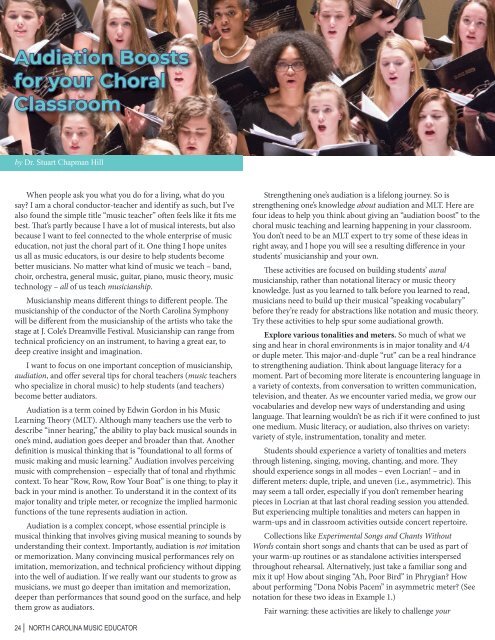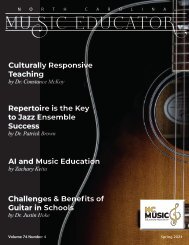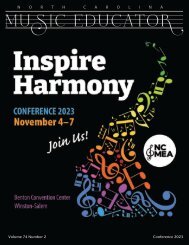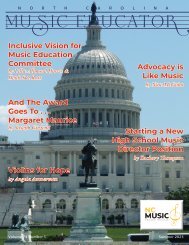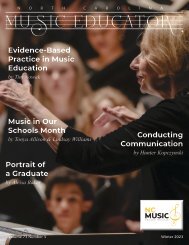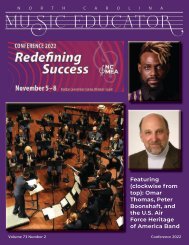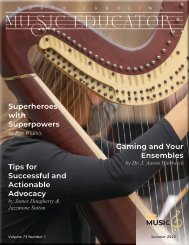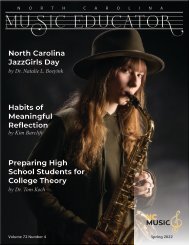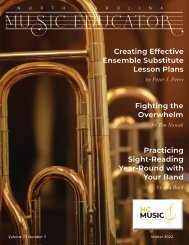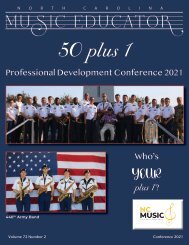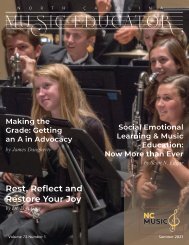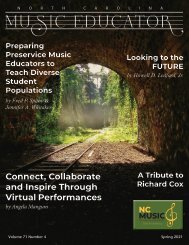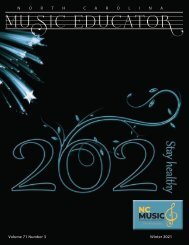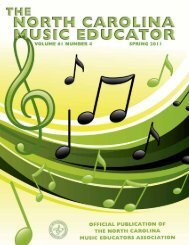NC Music Educator Winter 2024
NCMEA professional journal Winter 2024
NCMEA professional journal Winter 2024
Create successful ePaper yourself
Turn your PDF publications into a flip-book with our unique Google optimized e-Paper software.
Audiation Boosts<br />
for your Choral<br />
Classroom<br />
by Dr. Stuart Chapman Hill<br />
Example 1<br />
musicianship, not just your students’, and they may not go<br />
swimmingly at first. Don’t let any hiccups dissuade you from trying.<br />
That’s how learning works!<br />
Help students develop awareness of macro and micro beat.<br />
This suggestion seems simple, but it is crucial students develop an<br />
awareness of macro beat and micro beat. By “macro beat,” I mean<br />
the main steady pulse, and by “micro beat” I mean the divisions of<br />
that pulse.<br />
You can teach the chord roots to the class on a neutral syllable,<br />
on solfege, or on numbers representing the chord functions (i.e.,<br />
“one” for I, “four” for IV, “five” for V). Once students are familiar<br />
enough with both the original tune and the chord roots, you can<br />
divide the class in two parts, half on the melody and half on the<br />
chord roots. Then you can invite students to switch.<br />
This same approach works well with choral warm-ups, since<br />
so many of them are simple melodies with simple harmonic<br />
underpinnings. Example 3 is a familiar warmup, “Zingamama,”<br />
with chord roots notated underneath. (Note that I’ve had a bit of<br />
fun by making “Zingamama” minor instead of major – because it’s<br />
important to mix it up!)<br />
Example 3<br />
When people ask you what you do for a living, what do you<br />
say? I am a choral conductor-teacher and identify as such, but I’ve<br />
also found the simple title “music teacher” often feels like it fits me<br />
best. That’s partly because I have a lot of musical interests, but also<br />
because I want to feel connected to the whole enterprise of music<br />
education, not just the choral part of it. One thing I hope unites<br />
us all as music educators, is our desire to help students become<br />
better musicians. No matter what kind of music we teach – band,<br />
choir, orchestra, general music, guitar, piano, music theory, music<br />
technology – all of us teach musicianship.<br />
<strong>Music</strong>ianship means different things to different people. The<br />
musicianship of the conductor of the North Carolina Symphony<br />
will be different from the musicianship of the artists who take the<br />
stage at J. Cole’s Dreamville Festival. <strong>Music</strong>ianship can range from<br />
technical proficiency on an instrument, to having a great ear, to<br />
deep creative insight and imagination.<br />
I want to focus on one important conception of musicianship,<br />
audiation, and offer several tips for choral teachers (music teachers<br />
who specialize in choral music) to help students (and teachers)<br />
become better audiators.<br />
Audiation is a term coined by Edwin Gordon in his <strong>Music</strong><br />
Learning Theory (MLT). Although many teachers use the verb to<br />
describe “inner hearing,” the ability to play back musical sounds in<br />
one’s mind, audiation goes deeper and broader than that. Another<br />
definition is musical thinking that is “foundational to all forms of<br />
music making and music learning.” Audiation involves perceiving<br />
music with comprehension – especially that of tonal and rhythmic<br />
context. To hear “Row, Row, Row Your Boat” is one thing; to play it<br />
back in your mind is another. To understand it in the context of its<br />
major tonality and triple meter, or recognize the implied harmonic<br />
functions of the tune represents audiation in action.<br />
Audiation is a complex concept, whose essential principle is<br />
musical thinking that involves giving musical meaning to sounds by<br />
understanding their context. Importantly, audiation is not imitation<br />
or memorization. Many convincing musical performances rely on<br />
imitation, memorization, and technical proficiency without dipping<br />
into the well of audiation. If we really want our students to grow as<br />
musicians, we must go deeper than imitation and memorization,<br />
deeper than performances that sound good on the surface, and help<br />
them grow as audiators.<br />
Strengthening one’s audiation is a lifelong journey. So is<br />
strengthening one’s knowledge about audiation and MLT. Here are<br />
four ideas to help you think about giving an “audiation boost” to the<br />
choral music teaching and learning happening in your classroom.<br />
You don’t need to be an MLT expert to try some of these ideas in<br />
right away, and I hope you will see a resulting difference in your<br />
students’ musicianship and your own.<br />
These activities are focused on building students’ aural<br />
musicianship, rather than notational literacy or music theory<br />
knowledge. Just as you learned to talk before you learned to read,<br />
musicians need to build up their musical “speaking vocabulary”<br />
before they’re ready for abstractions like notation and music theory.<br />
Try these activities to help spur some audiational growth.<br />
Explore various tonalities and meters. So much of what we<br />
sing and hear in choral environments is in major tonality and 4/4<br />
or duple meter. This major-and-duple “rut” can be a real hindrance<br />
to strengthening audiation. Think about language literacy for a<br />
moment. Part of becoming more literate is encountering language in<br />
a variety of contexts, from conversation to written communication,<br />
television, and theater. As we encounter varied media, we grow our<br />
vocabularies and develop new ways of understanding and using<br />
language. That learning wouldn’t be as rich if it were confined to just<br />
one medium. <strong>Music</strong> literacy, or audiation, also thrives on variety:<br />
variety of style, instrumentation, tonality and meter.<br />
Students should experience a variety of tonalities and meters<br />
through listening, singing, moving, chanting, and more. They<br />
should experience songs in all modes – even Locrian! – and in<br />
different meters: duple, triple, and uneven (i.e., asymmetric). This<br />
may seem a tall order, especially if you don’t remember hearing<br />
pieces in Locrian at that last choral reading session you attended.<br />
But experiencing multiple tonalities and meters can happen in<br />
warm-ups and in classroom activities outside concert repertoire.<br />
Collections like Experimental Songs and Chants Without<br />
Words contain short songs and chants that can be used as part of<br />
your warm-up routines or as standalone activities interspersed<br />
throughout rehearsal. Alternatively, just take a familiar song and<br />
mix it up! How about singing “Ah, Poor Bird” in Phrygian? How<br />
about performing “Dona Nobis Pacem” in asymmetric meter? (See<br />
notation for these two ideas in Example 1.)<br />
Fair warning: these activities are likely to challenge your<br />
Awareness of different levels of beat is foundational for rhythmic<br />
audiation. Students need frequent opportunities to chant and move<br />
to the macro and micro beats in a variety of musical contexts.<br />
As students enter the classroom, you might play a recording of a<br />
school-appropriate popular song and lead students in movement on<br />
the macro and micro beats.<br />
You might play Kelly Clarkson’s “Breakaway” (a great example of<br />
triple meter) and have students sway left and right to the macro beat<br />
and then tap their shoulders on the micro beat. You could progress<br />
to trying macro and micro simultaneously, or you could divide<br />
the class in two groups, half micro and half macro, then switch the<br />
groups. You also could have students chant the macro and micro<br />
beats on a neutral syllable (like “bah”) or using your rhythm syllable<br />
system of choice. (I prefer to use the takadimi system, so for Kelly<br />
Clarkson’s “Breakaway,” half the class would chant macro beats on<br />
“ta” while the other chanted micro beats on “ta-ki-da.”)<br />
In addition to using recorded music for these macro and micro<br />
beat activities, bring them into your warm-ups and repertoire<br />
rehearsal as well. While rehearsing with one voice part, have the<br />
sections who aren’t singing be your “class metronome” and chant<br />
macro and/or micro beats. Or, while the whole ensemble sings<br />
a passage, have them all march or tap the macro or micro beat.<br />
Consistent use of these activities will boost your students’ rhythmic<br />
audiation—and likely have the added benefit of helping ensembles<br />
learn to avoid common rhythm problems like rushing.<br />
Help students develop harmonic awareness by singing chord<br />
roots. Students can develop an awareness and understanding of<br />
harmonic function – in an experiential way, not a theoretical one –<br />
by singing chord root melodies. The chord root melody is a simple<br />
melody that outlines the basic implied harmonic functions of the<br />
song. For example, here’s the first phrase of “Twinkle, Twinkle Little<br />
Star” with chord roots notated underneath (Example 2):<br />
Example 2<br />
When students hear and sing chord roots, they start to develop<br />
an awareness of the harmonic underpinnings of music, and in time,<br />
this harmonic awareness helps with things like tuning, and prepares<br />
students with the context they need to understand concepts like<br />
key signatures and chord progressions. Why not sing your choral<br />
warm-ups in two parts, with one part singing the melody and the<br />
other singing chord roots? It’s a simple addition that could pay big<br />
audiation benefits.<br />
These ideas are just the beginning, but I hope they’re an easy way<br />
to get started! If you are interested in learning more about MLT and<br />
audiation, check out resources like Eric Bluestine’s book, The Ways<br />
Children Learn <strong>Music</strong>, or the new book Q&A for MLT: Choral <strong>Music</strong><br />
Perspectives on <strong>Music</strong> Learning Theory, by Jill Reese, Krystal McCoy,<br />
and me. You might also want to keep an eye on the Gordon Institute<br />
for <strong>Music</strong> Learning website (giml.org) for workshops, including a<br />
summer professional development course focused on applying MLT<br />
to choral music.<br />
In the meantime, I encourage you to just be brave and give this<br />
stuff a try! In time, I hope you’ll find that you and your students are<br />
thinking about music and musicianship in new ways. Go ahead and<br />
give yourselves an audiation boost!<br />
References<br />
1<br />
Jill Reese, Krystal McCoy, and Stuart Chapman Hill, Q&A for<br />
MLT: Choral <strong>Music</strong> Perspectives on <strong>Music</strong> Learning Theory (Chicago:<br />
GIA Publications, 2023), 18.<br />
2<br />
Here, “triple meter” just means that each beat (or macro beat)<br />
of “Row Row…” is divided into three divisions (or micro beats).<br />
This terminology may be different from what you learned in music<br />
theory. For example, you may imagine this tune notated in 6/8 and<br />
therefore call it “compound duple.”<br />
3<br />
Edwin E. Gordon, Beth M. Bolton, Wendy K. Hicks, and<br />
Cynthia C. Taggart, Experimental Songs and Chants without Words:<br />
Book 1 (Chicago: GIA Publications, 1993).<br />
24 | NORTH CAROLINA MUSIC EDUCATOR NORTH CAROLINA MUSIC EDUCATOR | 25


